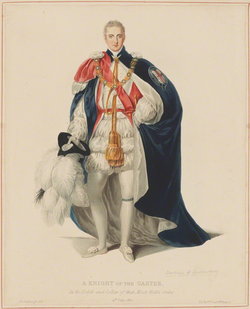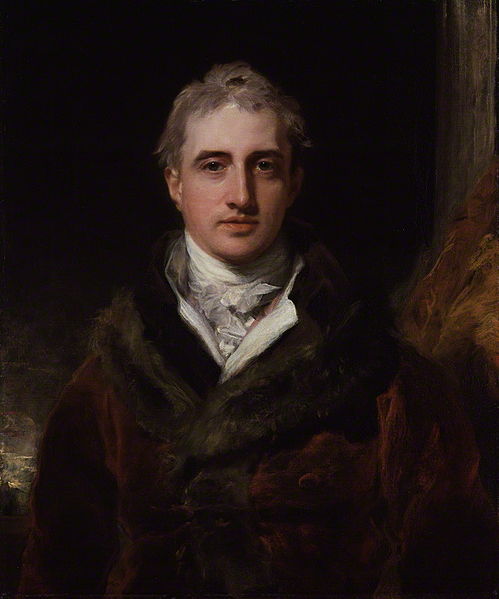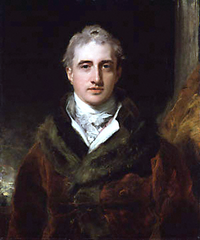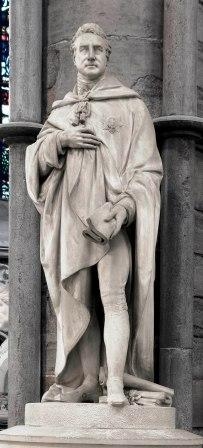Born in Dublin and educated in Armagh and Cambridge, he became member of the Irish parliament for Down in 1790. Although a Whig, he was an ally of Pitt the Younger, who in 1797 nominated him Lord of the Treasury and member of the Privy Council of Ireland. In 1800, together with Marquess Cornwallis, Castlereagh succeeded in steering the Irish Act of Union through both Parliaments. In 1802 President of the Board of Control, he became Secretary of State for War and the Colonies at the return of Pitt in 1804, in office (with a short interruption) until 1809, when he resigned after a duel affair. Returning as Foreign secretary in 1812, under Robert Banks Jenkinson, 2nd Earl of Liverpool, Castlereagh was instrumental in negotiating what has become known as the quadruple alliance between the United Kingdom, Austria, Russia and Prussia at Chaumont in March 1814. He was a protagonist in the negotiation of the Treaty of Paris that brought peace with France, and at the Congress of Vienna.
At Vienna he proposed a form of collective and collaborative security for Europe, then called Congress system. He promoted Russian-Prussian hegemony over Poland as well as Greek independence. Castlereagh was indulgent towards the Holy Alliance. By 1822, the system had collapsed because of irreconciliable antagonism between Britain, Austria and Russia.
At home, Castlereagh became more and more unpopular due to his open attitude to the conservative powers on the continent and his support for repressive measures in England. His mental health deteriorated. In his last meeting with King George IV he complained about blackmail resulting from alleged homosexual relations. Some hours later he died by suicide.
Copyright of the photo depicting his grave belonging to Westminster abbey; thanks to parish staff.
∼Robert Stewart, Viscount Castlereagh and 2nd Marquis of Londonderry,
politician, was buried in the centre of the north transept of Westminster Abbey, to the south of the grave of William Pitt and his son. The inscription on his grave has now worn away but it read:
"ROBERT MARQUIS OF LONDONDERRY.VISCOUNT CASTLEREAGH.BORN 18 JUNE 1769.DIED 12 AUG 1822"
STATUE
In 1823 an application was made by his brother to erect a bust in the Abbey but nothing seems to have come of this. But in 1849 permission was given for a statue to be placed near the grave. The larger than life white marble figure shows Robert in robes of the Order of the Garter, holding papers in his left hand, with more papers on the ground by his feet. The sculptor was John Evan Thomas. The inscription reads:
"This statue is erected to the memory of Robert Second Marquis of Londonderry, and Viscount Castlereagh K.G. Born A.D. 1769, Died August 12th 1822. History will record the success and splendour of his public career during a period of unexampled difficulty in the annals of Europe, in which he successfully filled the highest offices under the Crown, and Ireland will never forget the statesman of the legislative union. This tribute to the best of brothers and friends is placed in Westminster Abbey by Charles William Vane, Third Marquis of Londonderry".
LIFE AND CAREER
He was born in Dublin on 18 June 1769, the only surviving son of Robert Stewart of Mount Stewart in co.Down, and his first wife Lady Sarah Seymour Conway. He followed his father into politics. On 9 June 1794 he married Lady Amelia Hobart but they had no children. His debut in the Westminster Parliament was in 1795. When his father was created Earl of Londonderry in 1796 Robert had the courtesy title Viscount Castlereagh. His father was later created Marquis of Londonderry. He became a lord of the Irish Treasury and privy counsellor and retained his county seat in Dublin. He was secretary for War 1807-9, Foreign Secretary 1812-22 and he concluded the first Peace of Paris in 1814. At the First Congress of Vienna he was Senior British Plenipotentiary, and concluded the triple peace alliance with France and Austria in 1815. In 1821 he succeeded as 2nd Marquis of Londonderry. The strain of office caused him to take his own life by cutting his throat with a penknife at his country residence at North Cray in Kent. His Mount Stewart estate was left to his half brother Sir Charles who succeeded to his title. Lady Amelia was buried at the north east angle of the cloisters of the Abbey on 20 February 1829 but her grave is not marked.
Born in Dublin and educated in Armagh and Cambridge, he became member of the Irish parliament for Down in 1790. Although a Whig, he was an ally of Pitt the Younger, who in 1797 nominated him Lord of the Treasury and member of the Privy Council of Ireland. In 1800, together with Marquess Cornwallis, Castlereagh succeeded in steering the Irish Act of Union through both Parliaments. In 1802 President of the Board of Control, he became Secretary of State for War and the Colonies at the return of Pitt in 1804, in office (with a short interruption) until 1809, when he resigned after a duel affair. Returning as Foreign secretary in 1812, under Robert Banks Jenkinson, 2nd Earl of Liverpool, Castlereagh was instrumental in negotiating what has become known as the quadruple alliance between the United Kingdom, Austria, Russia and Prussia at Chaumont in March 1814. He was a protagonist in the negotiation of the Treaty of Paris that brought peace with France, and at the Congress of Vienna.
At Vienna he proposed a form of collective and collaborative security for Europe, then called Congress system. He promoted Russian-Prussian hegemony over Poland as well as Greek independence. Castlereagh was indulgent towards the Holy Alliance. By 1822, the system had collapsed because of irreconciliable antagonism between Britain, Austria and Russia.
At home, Castlereagh became more and more unpopular due to his open attitude to the conservative powers on the continent and his support for repressive measures in England. His mental health deteriorated. In his last meeting with King George IV he complained about blackmail resulting from alleged homosexual relations. Some hours later he died by suicide.
Copyright of the photo depicting his grave belonging to Westminster abbey; thanks to parish staff.
∼Robert Stewart, Viscount Castlereagh and 2nd Marquis of Londonderry,
politician, was buried in the centre of the north transept of Westminster Abbey, to the south of the grave of William Pitt and his son. The inscription on his grave has now worn away but it read:
"ROBERT MARQUIS OF LONDONDERRY.VISCOUNT CASTLEREAGH.BORN 18 JUNE 1769.DIED 12 AUG 1822"
STATUE
In 1823 an application was made by his brother to erect a bust in the Abbey but nothing seems to have come of this. But in 1849 permission was given for a statue to be placed near the grave. The larger than life white marble figure shows Robert in robes of the Order of the Garter, holding papers in his left hand, with more papers on the ground by his feet. The sculptor was John Evan Thomas. The inscription reads:
"This statue is erected to the memory of Robert Second Marquis of Londonderry, and Viscount Castlereagh K.G. Born A.D. 1769, Died August 12th 1822. History will record the success and splendour of his public career during a period of unexampled difficulty in the annals of Europe, in which he successfully filled the highest offices under the Crown, and Ireland will never forget the statesman of the legislative union. This tribute to the best of brothers and friends is placed in Westminster Abbey by Charles William Vane, Third Marquis of Londonderry".
LIFE AND CAREER
He was born in Dublin on 18 June 1769, the only surviving son of Robert Stewart of Mount Stewart in co.Down, and his first wife Lady Sarah Seymour Conway. He followed his father into politics. On 9 June 1794 he married Lady Amelia Hobart but they had no children. His debut in the Westminster Parliament was in 1795. When his father was created Earl of Londonderry in 1796 Robert had the courtesy title Viscount Castlereagh. His father was later created Marquis of Londonderry. He became a lord of the Irish Treasury and privy counsellor and retained his county seat in Dublin. He was secretary for War 1807-9, Foreign Secretary 1812-22 and he concluded the first Peace of Paris in 1814. At the First Congress of Vienna he was Senior British Plenipotentiary, and concluded the triple peace alliance with France and Austria in 1815. In 1821 he succeeded as 2nd Marquis of Londonderry. The strain of office caused him to take his own life by cutting his throat with a penknife at his country residence at North Cray in Kent. His Mount Stewart estate was left to his half brother Sir Charles who succeeded to his title. Lady Amelia was buried at the north east angle of the cloisters of the Abbey on 20 February 1829 but her grave is not marked.
Family Members
Advertisement
Records on Ancestry
Sponsored by Ancestry
Advertisement








